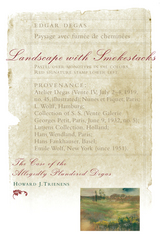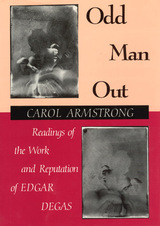3 books about 1834-1917

Degas
The Artist’s Mind
Theodore Reff
Harvard University Press, 1987
More than any other Impressionist, Degas consciously based his work on ideas. “What I do is the result of reflection and study of the great masters,” he once confessed; “of inspiration, spontaneity, temperament I know nothing.” Theodore Reff here shows us the intellectual power and originality of Degas’s complex art—as seen in his ingenious pictorial strategies and technical innovations; his use of motifs like the window, the mirror, the picture within the picture; his invention of striking, psychologically compelling compositions; and his creation of a sculptural idiom at once formal and vernacular. These essays also investigate Degas’s contacts with leading novelists and poets of his time and his efforts to illustrate or draw inspiration from their works.
[more]

Landscape with Smokestacks
The Case of the Allegedly Plundered Degas
Howard J. Treinens
Northwestern University Press, 2000
The dispute over Edgar Degas’s Landscape with Smokestacks was featured in newspapers and on television. But because the suit was settled before trial, the story behind the headlines was never publicly presented. Howard J. Trienens, a lawyer for the defendant collector, traces the landscape’s travels from its prewar home to its current location in the Art Institute of Chicago, laying out the mystery surrounding the work and demonstrating the legal complexities that plague Holocaust restitution cases, yet are seldom examined in depth by the media.
[more]

Odd Man Out
Readings of the Work and Reputation of Edgar Degas
Carol M. Armstrong
University of Chicago Press, 1991
In Odd Man Out, Carol Armstrong offers an important study of Edgar Degas's work and reputation. Armstrong grapples with contradictory portrayals of Degas as odd man out within the modernist canon: he was a realist whom realists rejected; he was a storyteller in pictures who did not satisfy novelist-critics; he painted modern life yet was no modernist; he belonged to the impressionist group yet was no impressionist. She confronts these and other contradictions by analyzing the critical vocabularies used to describe Degas's work.
By reading several groups of the artist's images through the lens of a sequence of critical texts, Armstrong shows how our critical and popular expectations of Degas are overturned and subverted. Each of these groups of images is matched to different interpretive moves, each highlighting distinct themes: economics and vocation; narrative and semiotics; gender and corporeality; and the author and self. Armstrong's provocative analysis celebrates the tantalizing qualities of the artist's elusive career: the pluralism of his work, its conflation of positivistic and negational tactics, the modern and the traditional, the abstract and the representational.
"A lucid and searching study. . . . Armstrong has produced one of the most elegant and persuasive examples of the historian's use of 19th-century art criticism. In the process, she has achieved a reading of the artist which makes a difference to the way we understand the difference of Degas himself."—Neil McWilliam, Times Higher Education Supplement
"This is a brilliant, original, and beautifully articulated study. Carol Armstrong's scholarship is impressive in its richness, ambition, and sophistication: Degas's works have rarely been given such detailed, penetrating, and suggestive readings as those offered in this book."—Linda Nochlin, Yale University
"With brilliant insight and incisive analytical intelligence, Carol Armstrong introduces new ways to conceptualize the structural ambiguities of Degas's work. Her subtle and probing readings clarify the fundamental contrariness of Degas's images—their disturbing negativity, their anti-modern modernism. Odd Man Out catapults the criticism of Degas from the hinterlands of traditional art history to the foreground of contemporary critical theory in both literature and the visual arts."—Charles Bernheimer, University of Pennsylvania
By reading several groups of the artist's images through the lens of a sequence of critical texts, Armstrong shows how our critical and popular expectations of Degas are overturned and subverted. Each of these groups of images is matched to different interpretive moves, each highlighting distinct themes: economics and vocation; narrative and semiotics; gender and corporeality; and the author and self. Armstrong's provocative analysis celebrates the tantalizing qualities of the artist's elusive career: the pluralism of his work, its conflation of positivistic and negational tactics, the modern and the traditional, the abstract and the representational.
"A lucid and searching study. . . . Armstrong has produced one of the most elegant and persuasive examples of the historian's use of 19th-century art criticism. In the process, she has achieved a reading of the artist which makes a difference to the way we understand the difference of Degas himself."—Neil McWilliam, Times Higher Education Supplement
"This is a brilliant, original, and beautifully articulated study. Carol Armstrong's scholarship is impressive in its richness, ambition, and sophistication: Degas's works have rarely been given such detailed, penetrating, and suggestive readings as those offered in this book."—Linda Nochlin, Yale University
"With brilliant insight and incisive analytical intelligence, Carol Armstrong introduces new ways to conceptualize the structural ambiguities of Degas's work. Her subtle and probing readings clarify the fundamental contrariness of Degas's images—their disturbing negativity, their anti-modern modernism. Odd Man Out catapults the criticism of Degas from the hinterlands of traditional art history to the foreground of contemporary critical theory in both literature and the visual arts."—Charles Bernheimer, University of Pennsylvania
[more]
READERS
Browse our collection.
PUBLISHERS
See BiblioVault's publisher services.
STUDENT SERVICES
Files for college accessibility offices.
UChicago Accessibility Resources
home | accessibility | search | about | contact us
BiblioVault ® 2001 - 2024
The University of Chicago Press









